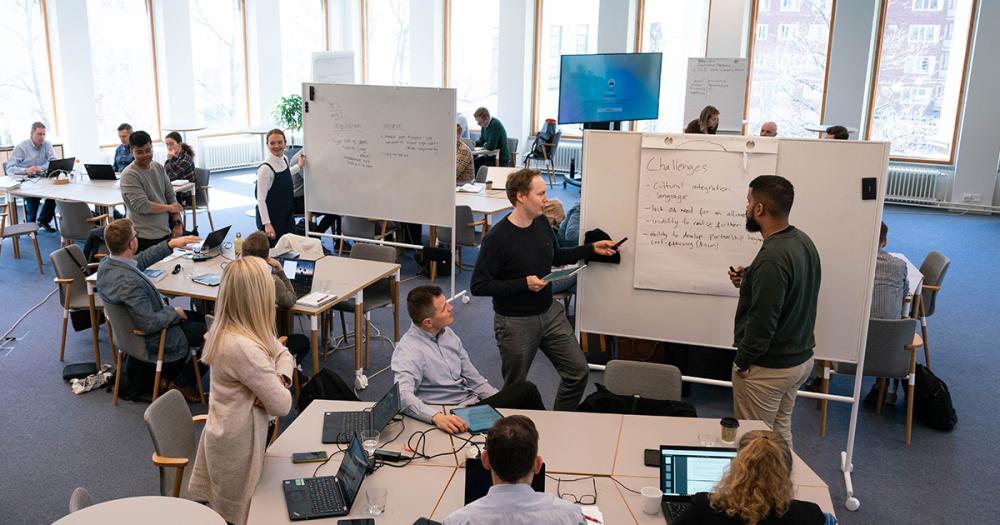Our Themes

AI and Digital Transformation
Enhance the digital transformation of your organisation. Our development programs will enable you to integrate new technologies into your organisation's business model and harness their full potential to benefit your business.
See training programs

Open Enrollment Programs

Finance
Finance programs focus on developing the key competences of financial professionals. The programs are designed for professionals in managerial and key roles within the finance function, as well as business decision-makers.
See training programs

Open Enrollment Programs

Leadership and General Management
Success requires visionary leadership and a unique ability to deliver value more and more effectively than your competitors. Challenge yourself to look at leadership from different perspectives and learn to act in new ways.
See training programs

Open Enrollment Programs

Security
Security builds trust and competitiveness in an increasingly complex and sometimes unpredictable environment. Challenges, but also opportunities, are created by technological change and the merging of the digital and physical worlds.
See training programs

Open Enrollment Programs

Strategy and Transformation
Strategic management training programs will help you set a long-term direction for the future and strengthen your ability to lead and implement strategy in a global context.
See training programs

Open Enrollment Programs

Sustainability
We help you build a socially, environmentally, and economically sustainable business. Our programs will help you understand how to integrate sustainability and responsibility into your business strategy.
See training programs

Open Enrollment Programs

Built Environment
We have been supporting built environment professionals and organizations through change for half a century. Our training courses combine research-based academic knowledge, the insights of leading experts in the field, and the practical experience of participants.
See training programs

Open Enrollment Programs

Design and Innovation
We help you develop your skills in creativity, strategic innovation, and service design. With us, you can create profitable business models that drive demand and growth.
See training programs

Open Enrollment Programs

Engineering
Engineering is the cornerstone of our society, enabling advances in energy, materials, infrastructure, and automation. Our training helps professionals to develop innovative and sustainable solutions in the fields of electrical, chemical, structural, and mechanical engineering.
See training programs

Open Enrollment Programs

Insurance and Risk Management
Insurance and risk management training programs, qualifications, and seminars support your development as an insurance and risk management expert.
See training programs

Open Enrollment Programs

Marketing and Sales
Our training programs will strengthen your strategic customer, marketing, and sales skills. Open and, if you wish, tailor-made packages ensure that you can align your objectives with your organisation's strategy and growth expectations.
See training programs

Open Enrollment Programs

Operations Management and Quality
Our operations and supply chain management training programs will help you anticipate change and develop your operations to achieve sustainable competitiveness. While business objectives remain, the means to achieve them have changed.
See training programs

Open Enrollment Programs
Discover Alex: Learning That Moves You Forward
Alex, the Aalto Learning Experience Platform, is your gateway to future-ready skills and recognized micro-credentials. Designed for ambitious professionals and forward-thinking organizations, Alex offers a constantly evolving portfolio of online courses and stackable learning paths that align with real-world demands. Whether you’re building leadership capacity, mastering sustainability, or diving into data and AI, Alex delivers flexible, high-quality learning from home. With verified digital credentials, personalized progress tracking, and content co-created with industry experts, Alex transforms learning into measurable impact.
Micro-Credentials
We at Aalto EE are dedicated to meeting the evolving learning needs of individuals and organizations by offering competency-based learning opportunities. We offer a constantly growing micro-credential portfolio that includes courses from short, self-paced online courses to in-depth diploma programs.
Training Programs Starting Next
Upcoming Events and Info Sessions
When Leadership Sabotages Strategy – What Growth-Driven Leadership Requires in 2026
No upcoming events
See also
MBA and DBA programs
Our program offerings include the part-time Aalto Master of Business Administration (MBA) program, the Aalto Executive MBA (EMBA) program, and the Aalto Executive Doctor of Business Administration (DBA) program.
Online Courses
Our online courses offer you the opportunity to study business and organizational management themes as well as develop essential skills and knowledge for experts at every stage of their career.
Labor Market Education
Our recruiting training courses will help you find a job that matches your skills.






















